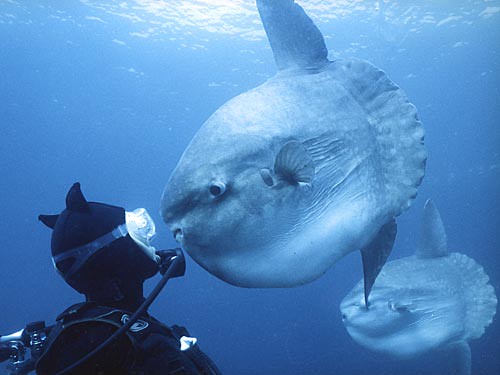Sydney Poetry
A social site for poets in Sydney.
My discontent with abyssopelagic
 Above: Sunfish in the epipelagic zone (Flickr: Hiroto Kitagawa). Below: Sunfish side on.
Above: Sunfish in the epipelagic zone (Flickr: Hiroto Kitagawa). Below: Sunfish side on.
I have a fondness for the adjective pelagic. It means of the open sea and comes from the Greek word pelagos for sea. It shares a little with the similar Greek word for the mysterious sea people who lived in Greece before the Dorians, the Pelasgians, who came from no one knows where and then disappeared back into history.

Pelagic is a soft-sounding, evocative word, creating a sense of otherworldliness, of things far from the dominion of man. It tends to be used in two senses: for seabirds, such as the albatross, that spend most of their time out in mid-ocean; or for fish, like the sunfish, that live and travel great distances on the uppermost levels of the sea.
Unfortunately, I have some cause for unhappiness as the scientists have got their rationalist hands on pelagic, and turned it into a technical adjective. For them, pelagic describes things of the ocean, from the low tide mark out to the open sea, and includes the whole volume of water from the surface to the bottom.
Scientists have taken the poetic and precise pelagic, which described the uppermost layer of the open ocean, and stripped the magic out of it. They have tacked on some Greek-derived prefixes and used it as a technical tag for all the depths of the seas.
 Epipelagic zone
Epipelagic zone
Epi- is a Greek prefix with a variety of meanings from: upon, beside, among, on the outside, above, over. The epipelagic zone from the surface down to 200 m is the zone where there is enough light for photosynthesis, so most of the ocean’s plants and animals live there.
Mesopelagic zone
Meso- is the Greek prefix for middle. The mesopelagic zone is from 200 to 1000 metres below the ocean surface. It is also known as the twilight zone because only some light penetrates this deep but not enough for photosynthesis.
Bathypelagic zone
Bathys is the Greek word for deep. No light penetrates this zone so it is also known as the midnight zone. The bathyal zone or bathypelagic zone extends from 1000 to 4000 metres depths.
Abyssopelagic zone
Abyss derives from the Greek word meaning bottomless. The abyssopelagic layer (from 4,000 to 6,000 metres) contains the very deep communities near the bottom of the ocean.
Hadopelagic zone
The zone gets its name from the Greek’s word for hell, Hades. The hadopelagic or hadal zone defines the deepest trenches in the ocean below 6,000 metres.
The scientifically derived zones have some interest for word buffs but are never going to find their way into poetry. Would Shakespeare have begun Richard III thus?
Now is the winter of our discontent
Made glorious summer by this sun of York;
And all the clouds that lour'd upon our house
In the abyssopelagic zone buried*.
[*In the deep bosom of the ocean buried.]
For more words of the week visit the Madrigal Communications blog.
Image of the ocean zones via wikipedia.
-
 Comment by Debbie Lim on July 25, 2011 at 10:37
Comment by Debbie Lim on July 25, 2011 at 10:37 -
Hi Tim, I enjoyed your post very much (and those images of the weird wonderful ocean sunfish). I'm fond of 'pelagic' too but wonder if there is a different beauty (albeit one with more syllables) to be found in the strange precision of terms like 'absyssopelagic' and 'hadopelagic'? Surely if those words are going to find appreciation out of a scientific journal or a nature documentary, it will be in poetry - because poetry is able to use language in transformative, rather than literal ways?
I guess where I would get bothered is if I wanted to use the more generally poetic 'pelagic' where it would be more scientifically precise to use, say, 'bathypelagic' (e.g. if I was writing a poem about a species that lived only in the bathypelagic zone). I've often wondered if the poet is obliged to use the more scientifically correct term, especially if not doing so might be inaccurate? Or do we have poetic license to use a less accurate more poetic word, given the context is a poem? It's such an interesting topic... thanks for raising it.
I admit your post particularly caught my attention as one of my favourite poems does use the word 'bathypelagic' (and ironically, not long ago I happened to write a poem about the ocean sunfish)!
Here's the bathypelagic poem. It's by the Scottish poet John Glenday:
The Ugly
I love you as I love the Hatchetfish,
the Allmouth, the Angler,
the Sawbelly and Wolf-eel,
the Stoplight Loosejaw, the Fangtooth;all our sweet bathypelagic ones,
and especially those too terrible or sly
even for Latin names; who saddle
their menfolk to the vagina’s hidelike scorched purses, stiff with seed;
whom God built to trawl
endless cathedrals of darkness,
their bland eyes gaping like wounds;who would choke down hunger itself,
had it pith and gristle enough;
who carry on their foreheads
the trembling light of the world.
-
Comment by Tim Entwisle on July 27, 2011 at 10:34
-
Debbie, Thanks for your comments on the post. I think I shot myself in the foot with this post—words are what you make of them and Glenday's poem proves that, marvellously well. My premise really was asking the question whether science has the right to requisition words and redefine them (and, of course, the answer it yes). But the corollary is that there is no requirement for us to accept science's definitions either. Words are used as we want them to be used and it is really a very democratic process despite what grammarians and writers of dictionaries sometimes tell us. That is my fascination with words—how they evolve with the quirks of a populous of users.
Add a Comment
On Facebook
@sydneypoetry
© 2024 Created by Adrian Wiggins.
Powered by
![]()
You need to be a member of Sydney Poetry to add comments!
Join Sydney Poetry